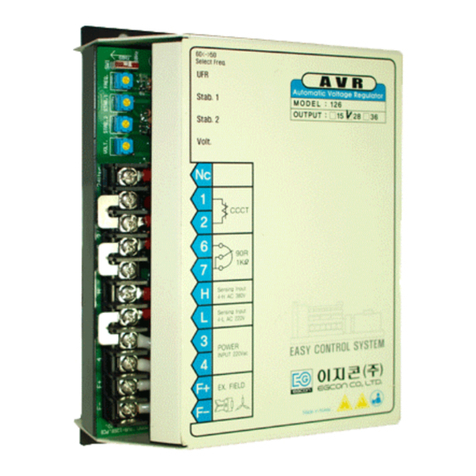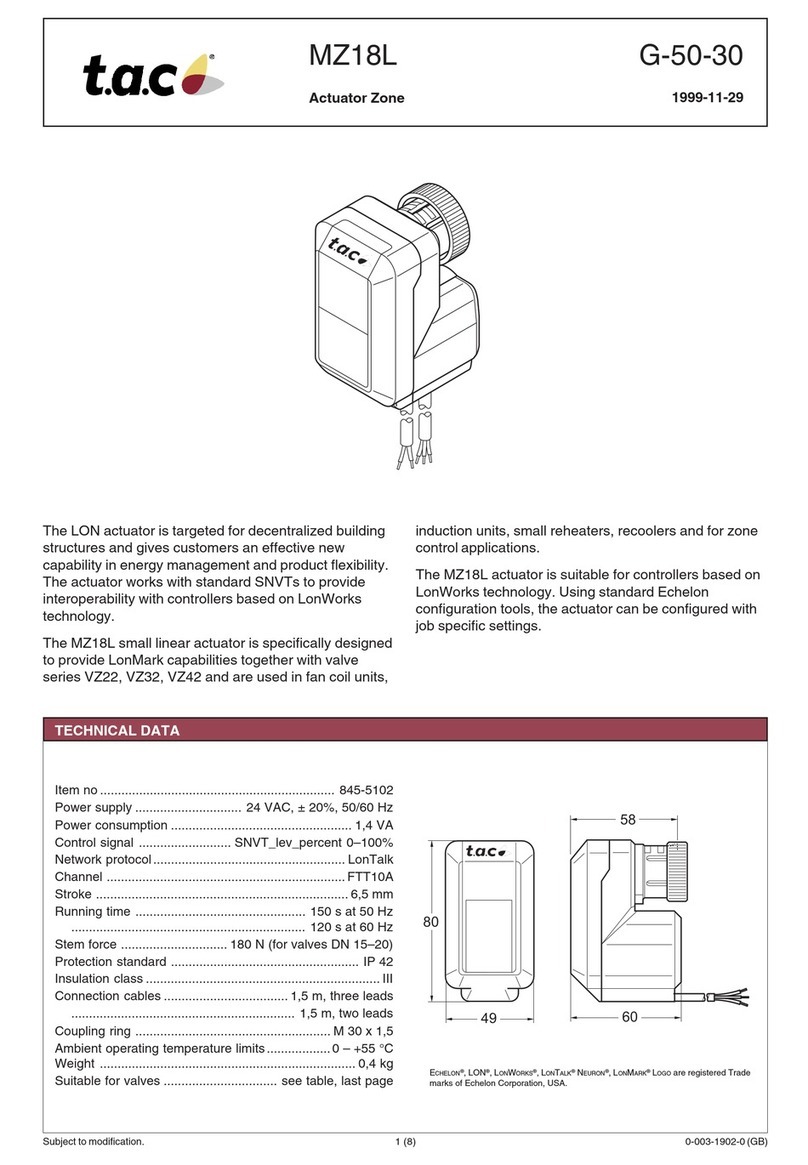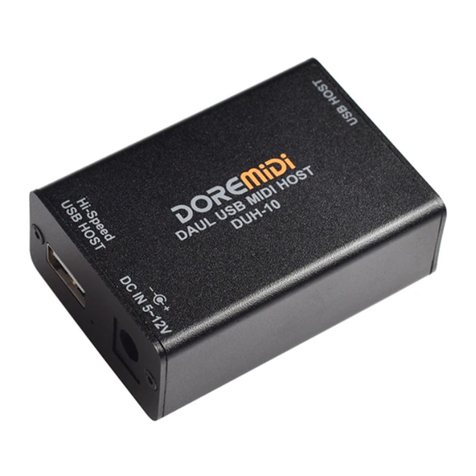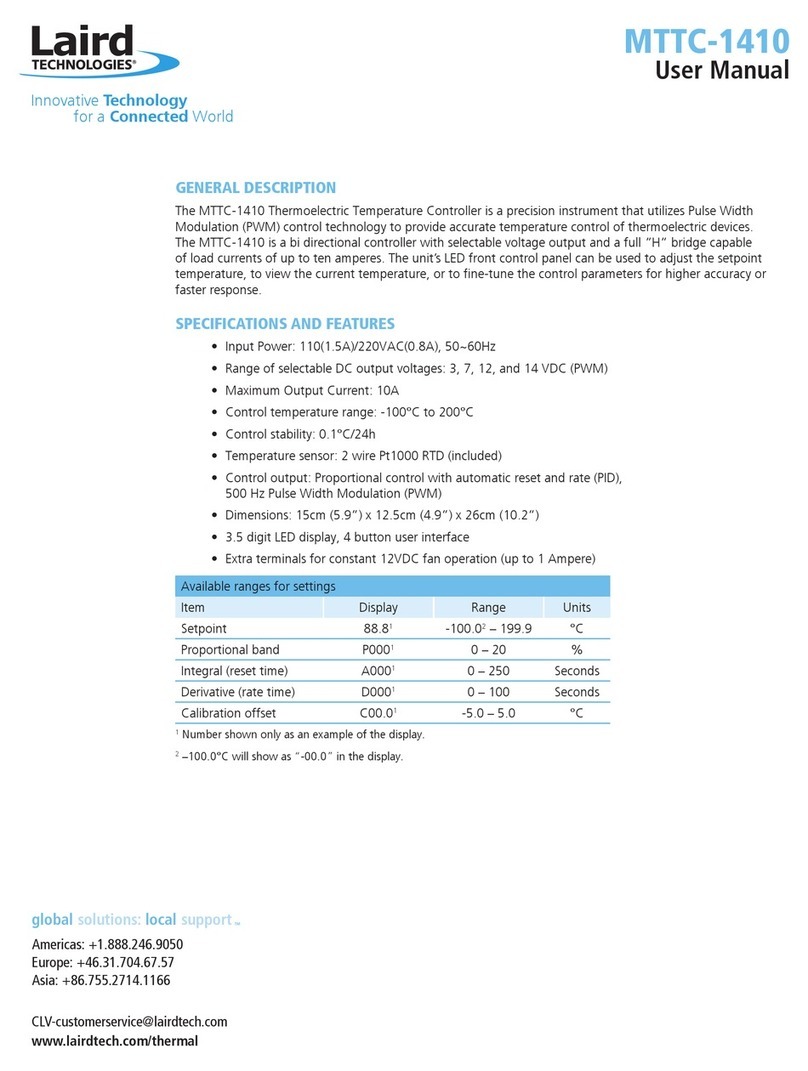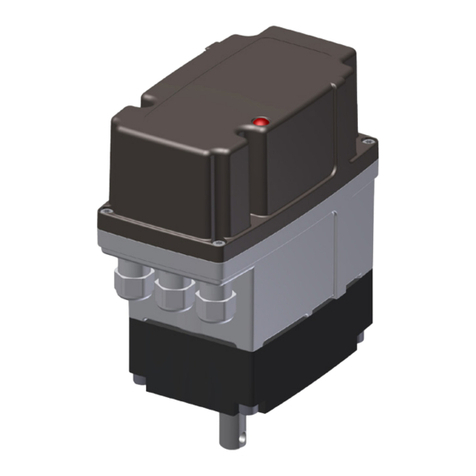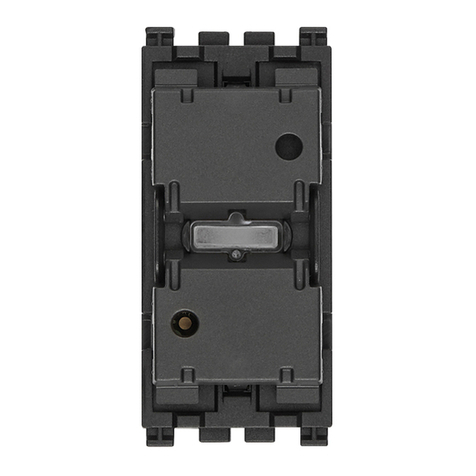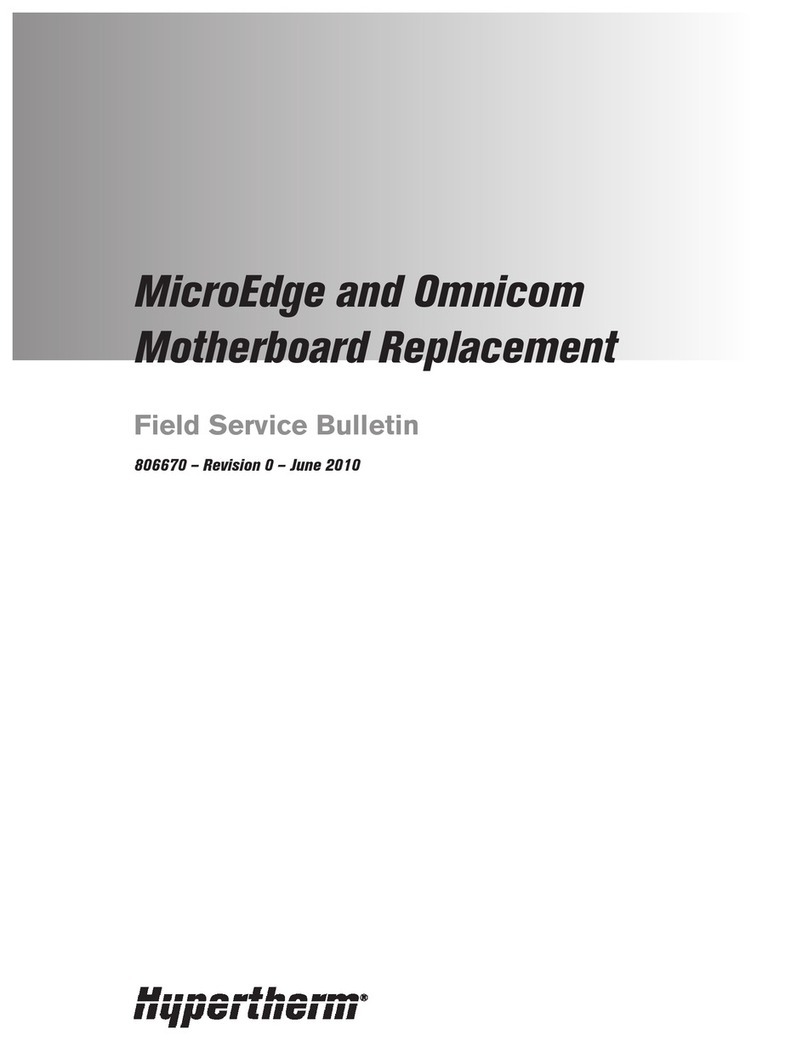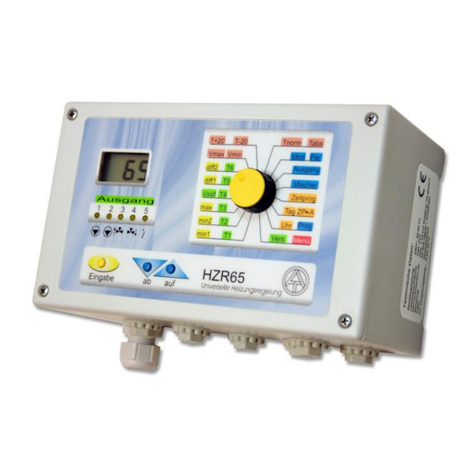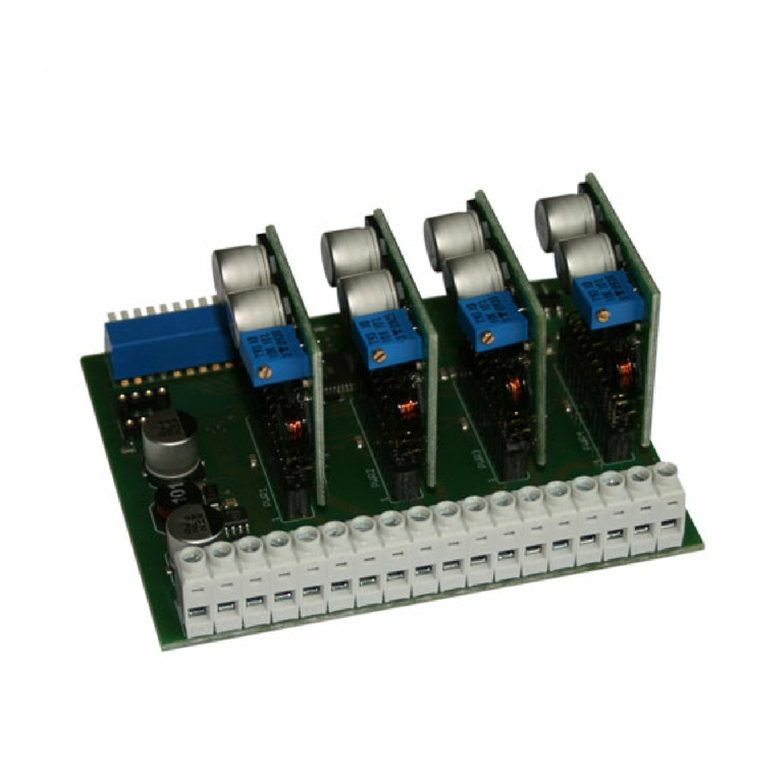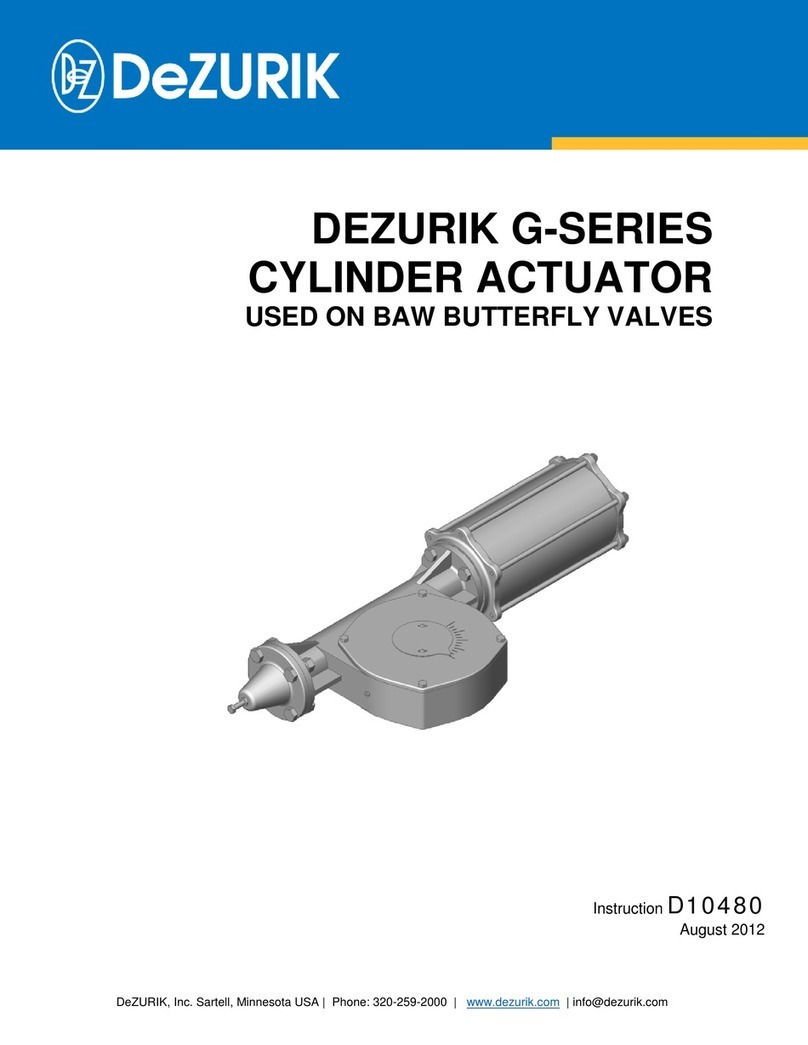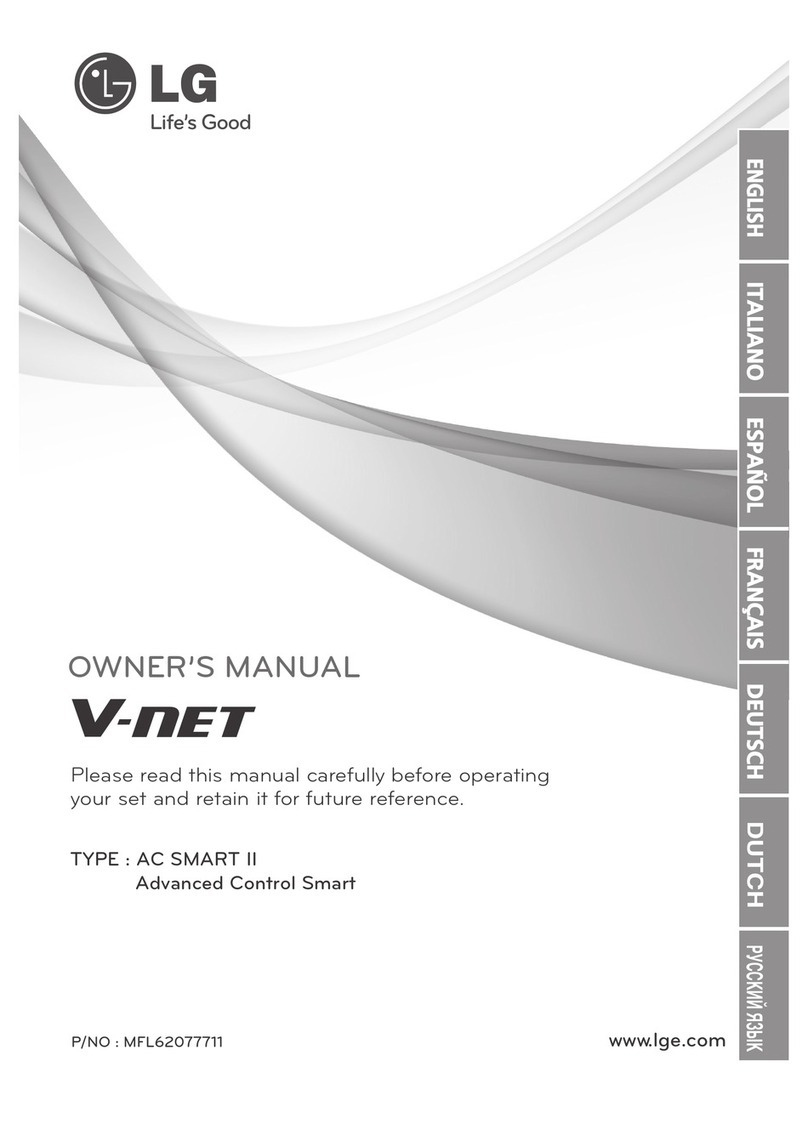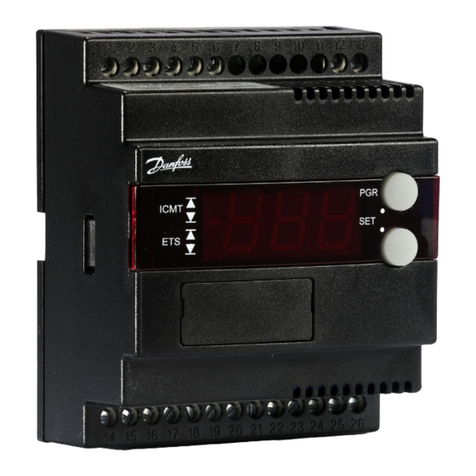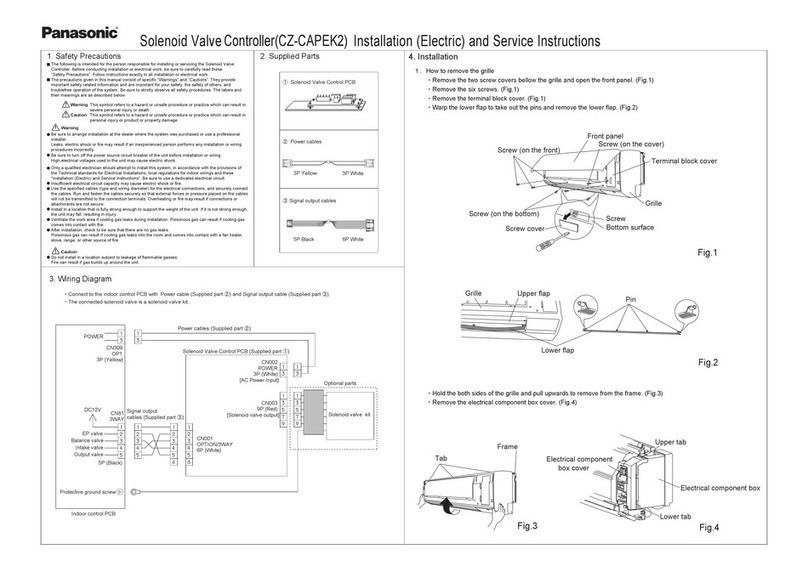Egcon FC3 User manual

2009. 05
AVR Manual
AVR(AUTOMATIC VOLTAGE REGULATOR)
MODEL : FC3
Contents◈ ◈
1. Introduction ····································································································3
2. Features ·········································································································· 3
3. Specifications ································································································3
4. Working conditions ······················································································4
5. structure ·········································································································· 4
6. Variable resistance ····················································································4
7. Connection ····································································································· 4
8. Check for operation ····················································································5
9. Adjusting ········································································································· 6
10. System start up ·························································································7
11. AVR operation test ····················································································7
12. Frequency-output voltage characteristic curve according to
frequency system ····························································································8
13. Trouble causes and solutions ·······························································8
Engine, Regulator Products
EGCON
Co,. Ltd
http://www.egcon.co.kr sales@egcon.co.kr
TEL: +82) 032-677-9806 FAX: +82) 032-677-9807

AVR - FC3 Operation Manual EGCON Co., Ltd
Notice
1. To use this product safely, please do understand operation manuals before use.
2. To prevent personal injury or equipment damage, matters that require attention must be
followed.
3. The matters that require attention are "Warning" and "Caution", the meaning is as
follows.
Warning
Incorrect use could cause
injury or death. Caution
Incorrect use could cause
personal injury or equipment
damage.
4. The symbols in operation manuals mean as follows
Be careful!, it could damage equipment. Be careful!, it could cause electric
shock.
5. Keep operation manuals close to the product.
1. Do not any wire works when the power is on or the main cable
is operated. It could cause electrocution or fire.
2. Do not assemble even if the power is off. The charged current
of inside equipment could cause electric shock.
3. Do not touch with a wet hand. It could cause electric shock.
4. Do not touch when wires are damaged. It could cause electric shock.
5. Do set up an earthing device to prevent electric shock.
Warning
1. Use rated power to prevent equipment damage or fire.
2. Keep foreign substances out to prevent short circuit or fire.
3. To prevent equipment damage or fire. connect a load
appropriate to the input or output capacity.
4. Connecting a random wire could cause equipment damage or fire.
5. Incorrect use could cause personal injury or the product and connected products damage.
Only qualified technicians and operators should use this device.
6. A test using high voltage such as a voltage withstand test or an insulation resistance test
could cause equipment damage. So separate them before testing.
7. Use a rated fuse and wire to prevent fire. .
8. This device is attached to a generator that vibrates a lot. So fasten it tight
9. Check loose part before installation.
Caution

AVR - FC3 Operation Manual EGCON Co., Ltd
1. Introduction
AVR-FC3 is an automatic voltage regulator.
2. Feature
2.1. Available for low exciter field resistance.
2.2. Excited early. (When residual voltage is left)
2.3. Less trouble. (no relay and no transformer)
2.4. Durable under dust, damp and vibration. ( SILICON MOLDING )
2.5. ingle phase radio wave control using SCR
2.6. Available to get input power(220Vac50Hz/60Hz/125Hz) from PMG(permanent magnetic generator) or
assisting winding
2.7. Parallel operation is available.
2.8. From an external device, voltage control is available.
2.9. Available to get 220Vac or 380Vac sensing voltage
2.10. Protecting AVR and generator by controlling low frequency.
2.11. Over output voltage protector setting.
2.12. Stability setting switch for large and small capacity generator.
2.13. Substitute model for AVR126.
3. Specification
3.1. Maximum continuous output : 125Vdc, 10A(1250W)
3.2. Maximum output for 10secs (240Vac input) : 200Vdc, 15A(3KW)
3.3. Power input: Single phase 180-270Vac ±10%, 50/60/125 Hz, 1.2KVA
3.4. Sensing input: Single phase 180-270Vac, 300-450Vac, 50/60Hz. 8VA.
3.5. Exciter field resistance : 18.3-100Ω
3.6. External voltage control resistor : 2 K , 2 WΩ
3.7. Voltage build-up: raised by residual voltage(min 5 Vac) of the generator.
3.8. Voltage stability : Less than ±1% between no load to full load
3.9. Responding time : Within 1.5 cycles while ±5% sensing voltage changes.
3.10. Available for Brushless, 50 / 60 Hz generator.
3.11. Parallel input : 5Aac, 2VA, On factor 0.8, droop is adjustable to about 6%
3.12. Assistant input :±30% of Voltage can change by receiving ±3Vdc, 0.6mVA as a signal.
3.13. Low-frequency protection : Working at 47Hz when 50Hz, at 57Hz when 60Hz.
3.14. Over excitation protection: When exciter field voltage goes over 75-125Vdc, AVR stops outputting
for a while. After detecting over input voltage, it outputs for 10 secs. But delayed time is getting
shorter as voltage goes higher. When output goes over 240Vdc, AVR shut off output instantly.
3.15. Power consumption: max. 35W.
3.16. Fixing bolt: Smaller than M5.
3.17. Size: W150 H135 - D36(mm), Cut-outl: W130 H115(mm)
3.18. Weight; 0.9Kg, 1Kg(including box)
3.19. High current-limiting fuse: 250Vac, 6.3A. 5 -20L.Φ

AVR - FC3 Operation Manual EGCON Co., Ltd
4. Working condition
4.1. Operating temperature: -20 ~ 40°C
4.2. Storage temperature: -40 ~ 60°C
4.3. Relative humidity: 0% ~ 90% with no
condensation
4.4. Vibration : Amplitude-0.35mm,
Frequency-0~30Hz
4.5. Max operating altitude: 3,000m
4.6. Indoor setting up unaffected by dust and salt
5. Structure
6. Variable resistance
6.1. VOLT. : Variable resistance for setting voltage
6.2. STAB. : Answering speed regulation resistance
6.3. UFR. : Low-frequency protector resistance ( preset in a factory )
6.4. OVX. : Over output voltage block regulation resistance
6.5. QDC. : Parallel operation voltage drop control resistance
6.6. STAB-ON : :Voltage stability setting switch
6.7. 60Hz/50Hz : Frequency system setting switch
7. Connection
7.1. After checking whether AVR is suitable for generator exciter, connect wires like below [Drawing1].
7.2. When using the external voltage controlled resistor, connect it to the terminal 6,7. Otherwise short
terminal 6,7.
7.3. Connect EX. FIELD to the terminal F+, F- . Conform with their electrode.
7.4. Supply AC220V to the terminal 3, 4.
7.5. If not using CCCT for parallel operation, short terminal1, 2.
7.6. If not using auxiliary input (ACC INPUT), terminal A, C.

AVR - FC3 Operation Manual EGCON Co., Ltd
7.7. When connecting sensing with 380V, cut off two jumpers on the part of 380V SESING CUTTING
JUMPER like below [Picture1].
(1) Remove the jumper at all, connect voltage detector as a 380V type.
[ Drawing1 ]
Warning Make sure that AC220V should be supplied to the terminal3, 4
[ Picture1 ]

AVR - FC3 Operation Manual EGCON Co., Ltd
8. Check for operation
8.1. Check again the generator capacity is correct.
8.2. Check it fastened tightly.
8.3. Check whether connection with the generator is correct.
8.4. Turn voltage regulator resistance(in AVR) counterclockwise to maximum.
8.5. When using external voltage control resistor, turn it to neutral. Otherwise short terminal 6,7.
8.6. According to a generator, turn frequency setting switch on. Do not adjust frequency control
resistance. Let it be like as set in a factory.
8.7. Turn voltage drop resistance for parallel operation(QDC) counterclockwise to maximum.
8.8. Turn stability control resistance to neutral and turn stability setting switch off.
9. Adjusting
9.1. Voltage stability adjusting
(1) Start up the engine and adjust it to rated voltage rated speed.
(2) Turn stability adjusting resistance(STAB.) clockwise until the point where voltage is unstable and
turn it counterclockwise little bit.
(3) Check whether response characteristic comes out by rated loading.
(4) If satisfactory response characteristic does not comes out, try again with stability adjusting switch
on.
(5) Usually a stability adjusting switch is used for mass generator.
9.2. Frequency adjusting
(1) According to frequency of generator, put a frequency setting switch on.
(2) Turn frequency adjusting resistance counterclockwise to maximum.
(3) Start up the engine and adjust it to rated voltage.
(4) Control engine speed to the frequency which is supposed to be controlled to low frequency.
(5) Turn UFR resistance clockwise untill a point where generator voltage starts to drop(when UFR LED
lamp lighting).
(6) Control the engine to rated speed.
9.3. Over excitation block adjusting
(1) It is a function to stop generator by shutting off AVR output when exciter field voltage rises over
set point.
(2) There are two actions. First, power generates for 10secs under 240Vdc. Delayed time is getting
shorter as voltage goes higher. Second, when output goes over 240Vdc, AVR shut off output
instantly.
(3) When AVR stops, to return to normal, the engine should be stopped or AVR's input should be
lower than 6Vac for 2 secs.
(4) Start up the engine and adjust it to rated voltage and rated speed.
(5) Supply rated load to generator.
(6) Measure AVR output voltage.
(7) To operate over voltage block adjusting resistance at low voltage, turn it counterclockwise.

AVR - FC3 Operation Manual EGCON Co., Ltd
9.4. Parallel operation voltage drop control resistance
(1) Connecting is very important. If sensing voltage is received from R phase and S phase, make
sure to connect CCCT to T phase.
(2) After removing a jumper at terminal1, 2, set CCCT which has 5A output current on rated load.
(3) Start up the engine and adjust it to rated voltage and rated speed.
(4) Apply rated load including factor to generator
(5) Check generator voltage falls down. If the voltage rises up, it means wrong CCCT electrode, so
switch CCCT electrode.
(6) If the voltage does not go up or down, it means voltage sensing phase is not matched with CCCT
phase, so set it up with a referential circuit diagram.
(7) To drop same voltage by applying same load to each generator, adjust voltage drop control
resistance(QDC).
10. System Start-up
10.1. Start up the engine and drive it at rated speed.
10.2. Check whether voltage is established or not.
10.3. If voltage is not established, disconnect F+ and F-wires and connect them to battery electrode
and check that generator voltage is established.
10.4. If generator residual voltage is lower than 5 Vac, set an early exciter circuit like below [drawing2]
Caution
Set early excitation short. When 24V battery is connected to the field without a R1
resistance and D1 diode, that could cause overvoltage.
[Drawing2 ]

AVR - FC3 Operation Manual EGCON Co., Ltd
11. AVR operation test
11.1. Connect wires like below [Drawing3].
11.2. A incandescent lamp should not exceed 100W.
11.3. Voltage is 220Vac 50hz or 60hz.
11.4. If turn voltage control resistance clockwise slowly to the maximum, the incandescent lamp is on.
11.5. If turning voltage control resistance counterclockwise slowly, the incandescent lamp is off.
11.6. At the point of turning off, if turning it clockwise little bit, the incandescent lamp is on and the
lamp is off if turning it counterclockwise a little. If it works, AVR is normal.
[Drawing3 ]
12. Frequency-output voltage characteristic curve according to frequency
system
[Frequency-output voltage characteristic curve]

AVR - FC3 Operation Manual EGCON Co., Ltd
13. Trouble causes and solutions.
Symptom Cause Solution
Generator output voltage
is below 30Vac. (Line
voltage)
No residual voltage in the
generator
Set an early exciter circuit with the
reference [Drawing2].
AVR fuse is burnt out Replace the fuse with a same capacity
one.
Disconnected wire or
incorrect connection
Correct wiring work referring circuit
diagram.
Generator output voltage
is over 50Vac and not
adjustable.(Line Voltage)
Terminal6 and 7 are not
connected.
If external variable resistance is not
connected, connect the terminal6 to
terminal7 with a short bar.
Generator speed is not
sufficient so frequency is
lower than standard.(UFL LED
turned on)
Control generator speed so that make out
rated frequency.
Incorrect wire connection Correct wiring work with the circuit
diagram.
Generator output voltage
is over 400Vac and not
adjustable.(Line Voltage)
A jumper on backside is
removed and voltage
detector connects with 220V.
If the jumper is removed, connect it with
380V.
Incorrect wire connection Correct wiring work with the circuit
diagram.
Hunting occurs Generator is not matched with
answering speed.
At first, adjust STAB variable resistance. If
Voltage is still unstable, turn STAB deep
switch on and adjust stability with STAB
variable resistance.

Table of contents
Other Egcon Controllers manuals
